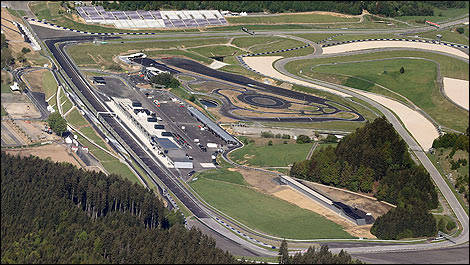The relative high altitude of the Red Bull Ring – scene of the Austrian Grand Prix this weekend – causes some concerns to the Formula 1 engine suppliers.
“There are only nine corners at the Red Bull Ring, which will not give the MGU-K many opportunities to recover significant energy under braking,” Remi Taffin, Renault Sport F1 head of track operations said.
“That said, we will need the MGU-K to feed the ICE with extra power, so making efficient use of the little energy recovered will be extremely important’,” he added.
The Austrian circuit is located around 700m above sea level, comparable to Interlagos, Brazil.
Normally aspirated engines, which rely on oxygen content in the air, are around 7% down on power at this altitude since power decreases by approx. 1% for every 100m in height, as there is less oxygen to burn at a higher altitude.
A turbocharged engine does not have this power drop off. It instead always pressures the ambient air to the same level inside the turbocharger and then compressor, ensuring there is always the same amount of oxygen content in the air inside the engine.
“The high altitude will cause the turbo to spin at a much higher rate to compensate for the low ambient pressure – very close to the hardware limit,” Taffin explained.
“We have recreated some of these climatic conditions on the dyno and feel confident we have a good handle on the preparations,” the French engineer said.
“There are only nine corners at the Red Bull Ring, which will not give the MGU-K many opportunities to recover significant energy under braking,” Remi Taffin, Renault Sport F1 head of track operations said.
“That said, we will need the MGU-K to feed the ICE with extra power, so making efficient use of the little energy recovered will be extremely important’,” he added.
The Austrian circuit is located around 700m above sea level, comparable to Interlagos, Brazil.
Normally aspirated engines, which rely on oxygen content in the air, are around 7% down on power at this altitude since power decreases by approx. 1% for every 100m in height, as there is less oxygen to burn at a higher altitude.
 |
| The Red Bull Ring. (Photo: Red Bull) |
A turbocharged engine does not have this power drop off. It instead always pressures the ambient air to the same level inside the turbocharger and then compressor, ensuring there is always the same amount of oxygen content in the air inside the engine.
“The high altitude will cause the turbo to spin at a much higher rate to compensate for the low ambient pressure – very close to the hardware limit,” Taffin explained.
“We have recreated some of these climatic conditions on the dyno and feel confident we have a good handle on the preparations,” the French engineer said.


